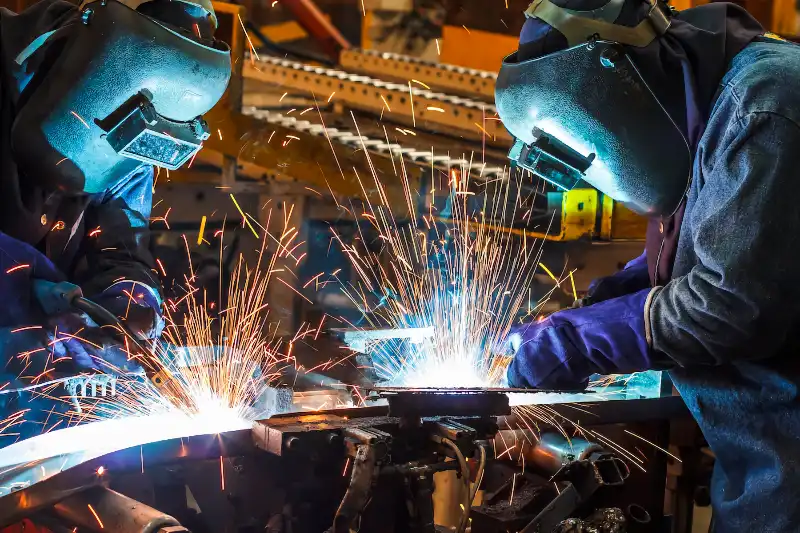Common Welding Codes in the Metal Fabrication Industry

The welding and metal fabrication industry is governed by codes and standards to ensure certain levels of quality and safety for customers and end users. Likewise, the metal fabrication company relies on welding codes to develop quality control systems and welding best practices to produce consistent results and to meet contractual specifications.
Several professional organizations are responsible for the development of welding codes for various industry applications. Welders and their employers can also participate in specialized technical training and testing to become certified by the governing organizations.
Here’s an overview of the top organizations that issue welding codes and what they mean for the metal fabrication industry.
Top Organizations That Issue Welding Codes and Standards
American Welding Society
The American Welding Society (AWS) is the most widely recognized producer of welding codes and standards for a wide range of industries in the United States. A welder and/or a metal fabrication company can become AWS certified. This means they’ve been proven to meet or exceed welding best practices for a variety of disciplines and welding processes.
In addition to MIG and TIG welding, there are requirements for brazing, laser welding, plasma welding, soldering, and other techniques. The AWS publishes numerous documents outlining standards that help address quality control for everything from welding definitions and processes, to safety and testing procedures. They also provide guidance on fabricating specific materials such as aluminum welding and stainless steel welding. Fox Valley Metal-Tech and its welders are AWS certified and have qualified AWS inspectors in-house to help streamline operations and ensure quality.
American Society of Mechanical Engineers
The American Society of Mechanical Engineers (ASME) develops boiler and pressure vessel codes and documents for pressure piping industries. Because of the added safety requirements in these industries, the ASME codes have strict standards for design, materials, fabrication, erection, inspection, and testing.
American Petroleum Institute
Unlike some other standards that govern U.S. industries only, the American Petroleum Institute (API) issues global standards that are used in nearly 100 countries. Its most recent update in July 2021, Standard 1104, 22nd Edition, takes new technology advancements and improvements into consideration for Welding of Pipelines and Related Facilities standards.
According to API, the new standards provide requirements for gas and arc welding used in the construction and in-service repair of pipes and components. These components are used for the compression, pumping, and pipeline transmission of crude oil, petroleum products, fuel gases, carbon dioxide, and nitrogen.
Government Agency Welding Standards
Other industries and governmental agencies may issue their own standards that metal fabricators must comply with and become qualified for in order to perform the work.
The Department of Defense, for example, issues its own requirements for metal fabricated parts used on U.S. Navy ships, submarines, aircraft carriers, and other military vessels. Because of the critical nature of these applications, some standards and tolerances may be more stringent than those issued by other agencies.
The U.S. Navy standards are referred to as NAVSEA (Naval Sea Systems Command). There are many overlapping requirements with AWS standards, and AWS requirements may be specified as part of a defense department project. However, NAVSEA is considered a separate entity and maintains its own standards.
Provisions of Welding Codes and Standards
While there are varying standards and documentation required across many of the organizations, they generally have similar elements and overarching themes in common. The metal fabrication company can reference the organization’s documentation to determine whether they’re qualified to perform the work. Some portions of this documentation will include:
Scope and General Requirements: All governing organizations will clearly document the project description and the type of welding fabrication required. Potential limitations, exemptions, or provisions for the application will also be specified. This is typically provided as an overview in the introduction to any qualifying documentation.
Design of Welded Connections: A section of the documentation will outline design specifications or might refer to an addendum containing more detailed design information. In it will be minimum requirements and other information related to the design of individual weldments.
Qualifications: Welding procedure specifications and performance qualifications will be provided for fabricators and outline test records for their ability to comply with specified requirements for welding. Some of these qualifications might include welding of various base metals, dissimilar materials, achieving base metal thickness ranges, joint design, and more. The sizes and types of test samples, test methods, and minimum criteria will also be included.
Fabrication: Fabrication methods and requirements, such as materials, equipment, weld settings, and other specifications are provided in the Fabrication section of the document. Other procedural details might include pre-weld cleaning, joint preparation, temperature controls, post-weld processing, filler materials, weld shielding, and record requirements.
Inspection: A final section includes criteria outlining the qualifications of the inspection personnel and procedural testing requirements. These requirements will include a visual weld inspection by a certified inspector, acceptance criteria, and inspection records. Additionally, nondestructive testing (NDT) by a certified NDT Level III inspector is typically required using approved written procedures.
Choosing a Qualified Metal Fabrication Company
Complying with numerous welding codes requires a metal fabrication company that is dedicated to quality workmanship. Delivering projects that meet or exceed specifications outlined by the customer should be the highest goal. Whether you’re specifying criteria for a general commercial application or a highly sophisticated military operation, knowing that your metal fabricator and their team of welders are certified to achieve strict compliance requirements can put your mind at ease.
There’s a lot more to consider than compliance requirements when issuing a request for quote (RFQ), however. Make sure you don’t miss other important details by downloading our Metal Fabrication RFQ Guide — A Checklist of Commonly Overlooked Specifications. Just click the link below.
Fox Valley Metal-Tech is a leader in the welding and metal fabrication industry for both commercial and defense clients. Our team has achieved numerous certifications, ensuring top-rated skills, processes, materials, and equipment. Contact our experts today to discuss your project needs.
